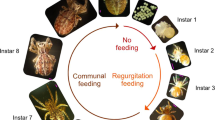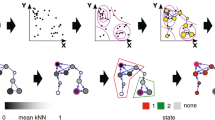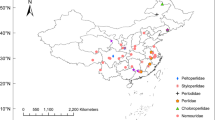Abstract
Co-evolutionary theory predicts that if beneficial microbial symbionts improve host fitness, they should be faithfully transmitted to offspring. More recently, the hologenome theory of evolution predicts resemblance between parent and offspring microbiomes and high partner fidelity between host species and their vertically transmitted microbes. Here, we test these ideas in multiple coexisting host species with highly diverse microbiota, leveraging known parent–offspring pairs sampled from eight species of wild marine sponges (Porifera). We found that the processes governing vertical transmission were both neutral and selective. A neutral model was a better fit to larval (R 2 = 0.66) than to the adult microbiota (R 2 = 0.27), suggesting that the importance of non-neutral processes increases as the sponge host matures. Microbes that are enriched above neutral expectations in adults were disproportionately transferred to offspring. Patterns of vertical transmission were, however, incomplete: larval sponges shared, on average, 44.8% of microbes with their parents, which was not higher than the fraction they shared with nearby non-parental adults. Vertical transmission was also inconsistent across siblings, as larval sponges from the same parent shared only 17% of microbes. Finally, we found no evidence that vertically transmitted microbes are faithful to a single sponge host species. Surprisingly, larvae were as likely to share vertically transmitted microbes with larvae from other sponge species as they were with their own species. Our study demonstrates that common predictions of vertical transmission that stem from species-poor systems are not necessarily true when scaling up to diverse and complex microbiomes.
This is a preview of subscription content, access via your institution
Access options
Access Nature and 54 other Nature Portfolio journals
Get Nature+, our best-value online-access subscription
$29.99 / 30 days
cancel any time
Subscribe to this journal
Receive 12 digital issues and online access to articles
$119.00 per year
only $9.92 per issue
Buy this article
- Purchase on Springer Link
- Instant access to full article PDF
Prices may be subject to local taxes which are calculated during checkout






Similar content being viewed by others
Data availability
All sequence data are part of the Sponge EMP and can be downloaded from https://github.com/amnona/SpongeEMP. Data and code used in the focal study can be downloaded from https://osf.io/jg69k/. The raw sequences analysed in this study can be extracted from the Sponge EMP data using the accession numbers available in the focal metadata.
Change history
02 March 2021
A Correction to this paper has been published: https://doi.org/10.1038/s41559-021-01419-x
References
Koch, H. & Schmid-Hempel, P. Socially transmitted gut microbiota protect bumble bees against an intestinal parasite. Proc. Natl Acad. Sci. USA 108, 19288–19292 (2011).
Smith, P. et al. Regulation of life span by the gut microbiota in the short-lived African turquoise killifish. eLife 6, e27014 (2017).
Kwong, W. K., Mancenido, A. L. & Moran, N. A. Immune system stimulation by the native gut microbiota of honey bees. R. Soc. Open Sci. 4, 170003 (2017).
Funkhouser, L. J. & Bordenstein, S. R. Mom knows best: the universality of maternal microbial transmission. PLoS Biol. 11, 1–9 (2013).
Fisher, R. M., Henry, L. M., Cornwallis, C. K., Kiers, E. T. & West, S. A. The evolution of host-symbiont dependence. Nat. Commun. 8, 15973 EP (2017).
Hartmann, A. C., Baird, A. H., Knowlton, N. & Huang, D. The paradox of environmental symbiont acquisition in obligate mutualisms. Curr. Biol. 27, 3711–3716.e3 (2017).
Russell, S. L. Transmission mode is associated with environment type and taxa across bacteria-eukaryote symbioses: a systematic review and meta-analysis. FEMS Microbiol. Lett. 366, fnz013 (2019).
Zilber-Rosenberg, I. & Rosenberg, E. Role of microorganisms in the evolution of animals and plants: the hologenome theory of evolution. FEMS Microbiol. Rev. 32, 723–735 (2008).
Bordenstein, S. R. & Theis, K. R. Host biology in light of the microbiome: ten principles of holobionts and hologenomes. PLoS Biol. 13, e1002226 (2015).
Moran, N. A. & Sloan, D. B. The hologenome concept: helpful or hollow? PLoS Biol. 13, 1–10 (2015).
Douglas, A. E. & Werren, J. H. Holes in the hologenome: why host-microbe symbioses are not holobionts. mBio 7, e02099-15 (2016).
Rosenberg, E. & Zilber-Rosenberg, I. The hologenome concept of evolution after 10 years. Microbiome 6, 78 (2018).
Ewald, P. W. Transmission modes and evolution of the parasitism-mutualism continuum. Ann. New Y. Acad. Sci. 503, 295–306 (1987).
Bull, J. J., Ian Molineux, J. & Rice, W. R. Selection of benevolence in a host-parasite system. Evolution 45, 875–882 (1991).
Yamamura, N. Vertical transmission and evolution of mutualism from parasitism. Theor. Popul. Biol. 44, 95–109 (1993).
Douglas, A. E. Symbiotic Interactions (Oxford Science Publications, 1994).
Thompson, J. N. The Coevolutionary Process (Univ. of Chicago Press, 1994).
Herre, E. A., Knowlton, N., Mueller, U. G. & Rehner, S. A. The evolution of mutualisms: exploring the paths between conflict and cooperation. Trends Ecol. Evol. 14, 49–53 (1999).
Wilkinson, D. M. & Sherratt, T. N. Horizontally acquired mutualisms, an unsolved problem in ecology? Oikos 92, 377–384 (2001).
Sachs, J. L., Skophammer, R. G. & Regus, J. U. Evolutionary transitions in bacterial symbiosis. Proc. Natl Acad. Sci. USA 108, 10800 (2011).
Buchner, P. Endosymbiosis of Animals with Plant Microorganisms (Interscience Publishers, 1965).
Mclaren, D. J., Worms, M. J., Laurence, B. R. & Simpson, M. G. Micro-organisms in filarial larvae (Nematoda). Trans. R. Soc. Trop. Med. Hyg. 69, 509–514 (1975).
Fukatsu, T. & Hosokawa, T. Capsule-transmitted gut symbiotic bacterium of the Japanese common plataspid stinkbug, Megacopta punctatissima. Appl Environ. Microbiol. 68, 389–396 (2002).
Bates, J. M. et al. Distinct signals from the microbiota promote different aspects of zebrafish gut differentiation. Dev. Biol. 297, 374–386 (2006).
Kikuchi, Y., Hosokawa, T. & Fukatsu, T. Insect-microbe mutualism without vertical transmission: a stinkbug acquires a beneficial gut symbiont from the environment every generation. Appl. Environ. Microbiol. 73, 4308 (2007).
Ho, P. T. et al. Geographical structure of endosymbiotic bacteria hosted by Bathymodiolus mussels at Eastern Pacific hydrothermal vents. BMC Evolut. Biol. 17, 121 (2017).
Genkai-Kato, M. & Yamamura, N. Evolution of mutualistic symbiosis without vertical transmission. Theor. Popul. Biol. 55, 309–323 (1999).
Nyholm, S. V., Stabb, E. V., Ruby, E. G. & McFall-Ngai, M. J. Establishment of an animal-bacterial association: recruiting symbiotic vibrios from the environment. Proc. Natl Acad. Sci. USA 97, 10231 (2000).
Dubilier, N. et al. Endosymbiotic sulphate-reducing and sulphide-oxidizing bacteria in an oligochaete worm. Nature 411, 298 EP (2001).
Mushegian, A. A., Walser, J. C., Sullam, K. E. & Ebert, D. The microbiota of diapause: how host-microbe associations are formed after dormancy in an aquatic crustacean. J. Anim. Ecol. 87, 400–413 (2017).
Yin, Z. et al. Sponge grade body fossil with cellular resolution dating 60 Myr before the cambrian. Proc. Natl Acad. Sci. USA 112, E1453–E1460 (2015).
Taylor, M. W., Radax, R., Stegar, D. & Wagner, M. Sponge-associated microorganisms: evolution, evology, and biotechnological potential. Microbiol. Mol. Biol. Rev. 71, 295–347 (2007).
Fan, L. et al. Functional equivalence and evolutionary convergence in complex communities of microbial sponge symbionts. Proc. Natl Acad. Sci. USA 109, E1878–E1887 (2012).
Goeij, J. M. D. et al. Surviving in a marine desert: the sponge loop retains resources within coral reefs. Science 342, 108–110 (2013).
Sará, M. V. J. & Grassé, P. P. (eds) Traité de Zoologie Spongiaires 462–576 (Masson et Cie, 1973).
Uriz, M. J., Xavier, T. & Mikel, A. B. Morphology and ultrastructure of the swimming larvae of Crambe crambe (Demospongiae, Poecilosclerida). Invertebr. Biol. 120, 295–307 (2001).
de Caralt, S., Uriz, M. J. & Wijffels, R. H. Vertical transmission and successive location of symbiotic bacteria during embryo development and larva formation in corticium candelabrum (Porifera: Demospongiae). J. Mar. Biol. Assoc. U.K. 87, 1693–1699 (2007).
Uriz, M. J., Turon, X. & Mariani, S. Ultrastructure and dispersal potential of sponge larvae: tufted versus evenly ciliated parenchymellae. Mar. Ecol. 29, 280–297 (2008).
Schmitt, S., Angermeier, H., Schiller, R., Lindquist, N. & Hentschel, U. Molecular microbial diversity survey of sponge reproductive stages and mechanistic insights into vertical transmission of microbial symbionts. Appl. Environ. Microbiol. 74, 7694–7708 (2008).
Hentschel, U. et al. Molecular evidence for a uniform microbial community in sponges from different oceans molecular evidence for a uniform microbial community in sponges from different oceans. Appl. Environ. Microbiol. 68, 4431–4440 (2002).
Simister, R. L., Deines, P., Botté, E. S., Webster, N. S. & Taylor, M. W. Sponge-specific clusters revisited: a comprehensive phylogeny of sponge-associated microorganisms. Environ. Microbiol. 14, 517–524 (2012).
Vacelet, J. & Donadey, C. Electron microscope study of the association between some sponges and bacteria. J. Exp. Mar. Biol. Ecol. 30, 301–314 (1977).
Usher, K. M., Kuo, J., Fromont, J. & Sutton, D. C. Vertical transmission of cyanobacterial symbionts in the marine sponge Chondrilla australiensis (Demospongiae). Hydrobiologia 461, 9–13 (2001).
Ereskovsky, A. V. & Tokina, D. B. Morphology and fine structure of the swimming larvae of Ircinia oros (Porifera, Demospongiae, Dictyoceratida). Invertebr. Reprod. Dev. 45, 137–150 (2004).
Ereskovsky, A. V., Gonobobleva, E. & Vishnyakov, A. Morphological evidence for vertical transmission of symbiotic bacteria in the viviparous sponge Halisarca dujardini Johnston (Porifera, Demospongiae, Halisarcida). Mar. Biol. 146, 869–875 (2005).
Maldonado, M. Intergenerational transmission of symbiotic bacteria in oviparous and viviparous demosponges, with emphasis on intracytoplasmically-compartmented bacterial types. J. Mar. Biol. Assoc. U.K. 87, 1701–1713 (2007).
Riesgo, A. & Maldonado, M. Differences in reproductive timing among sponges sharing habitat and thermal regime. Invertebr. Biol. 127, 357–367 (2008).
Maldonado, M. & Riesgo, A. Gametogenesis, embryogenesis, and larval features of the oviparous sponge Petrosia ficiformis (Haplosclerida, Demospongiae). Mar. Biol. 156, 2181–2197 (2009).
Enticknap, J. J., Kelly, M., Peraud, O. & Hill, R. T. Characterization of a culturable alphaproteobacterial symbiont common to many marine sponges and evidence for vertical transmission via sponge larvae. Appl. Environ. Microbiol. 72, 3724–3732 (2006).
Schmitt, S., Weisz, J. B., Lindquist, N. & Hentschel, U. Vertical transmission of a phylogenetically complex microbial consortium in the viviparous sponge Ircinia felix. Appl. Environ. Microbiol. 73, 2067–2078 (2007).
Lee, O. O., Chiu, P. Y., Wong, Y. H., Pawlik, J. R. & Qian, P. Y. Evidence for vertical transmission of bacterial symbionts from adult to embryo in the Caribbean sponge Svenzea zeai. Appl. Environ. Microbiol. 75, 6147–6156 (2009).
Webster, N. S. et al. Deep sequencing reveals exceptional diversity and modes of transmission for bacterial sponge symbionts. Environ. Microbiol. 12, 2070–2082 (2010).
Sharp, K. H., Eam, B., John Faulkner, D. & Haygood, M. G. Vertical transmission of diverse microbes in the tropical sponge Corticium sp. Appl. Environ. Microbiol. 73, 622–629 (2007).
Kamke, J. et al. The candidate phylum poribacteria by single-cell genomics: new insights into phylogeny, cell-compartmentation, eukaryote-like repeat proteins, and other genomic features. PLoS ONE 9 (2014).
Bayer, K., Jahn, M. T., Slaby, B. M., Moitinho-Silva, L. & Hentschel, U. Marine sponges as Chloroflexi hot spots: genomic insights and high-resolution visualization of an abundant and diverse symbiotic clade. mSystems 6, e00150-18 (2018).
Carmen, A. G. et al. Phylogeny and genomics of SAUL, an enigmatic bacterial lineage frequently associated with marine sponges. Environ. Microbiol. 20, 561–576 (2017).
Pedrós-Alió, C. Dipping into the rare biosphere. Science 315, 192 (2007).
Taylor, M. W. et al. ‘Sponge-specific’ bacteria are widespread (but rare) in diverse marine environments. ISME J. 7, 438–443 (2013).
Sloan, W. T. et al. Quantifying the roles of immigration and chance in shaping prokaryote community structure. Environ. Microbiol. 8, 732–740 (2006).
Burns, A. R. et al. Contribution of neutral processes to the assembly of gut microbial communities in the zebrafish over host development. ISME J. 10, 655 EP (2015).
Usher, K. M., Sutton, D. C., Toze, S., Kuo, J. & Fromont, J. Inter-generational transmission of microbial symbionts in the marine sponge Chondrilla australiensis (Demospongiae). Mar. Freshw. Res. 56, 125–131 (2005).
Kaye, H. R. & Reiswig, H. M. Sexual reproduction in four Caribbean commercial sponges. III. Larval behaviour, settlement and metamorphosis. Invertebr. Reprod. Dev. 19, 25–35 (1991).
Kaye, H. R. Sexual reproduction in four Caribbean commercial sponges. II. Oogenesis and transfer of bacterial symbionts. Invertebr. Reprod. Dev. 19, 13–24 (1991).
Gaino, E., Burlando, B., Buffa, P. & Sará, M. Ultrastructural study of the mature egg of Tethya citrina Sará & Melone (Porifera, Demospongiae). Gamete Res. 16, 259–265 (1987).
Sciscioli, M., Liaci, L. S., Lepore, E., Gherardi, M. & Simpson, T. L. Ultrastructural study of the mature egg of the marine sponge Stelletta grubii (Porifera, Demospongiae). Mol. Reprod. Dev. 28, 346–350 (1991).
Sciscioli, M., Lepore, E., Gherardi, M. & Liaci, L. S. Transfer of symbiotic bacteria in the mature oocyte of. Geodia cydonium (Porifera, Demosponsgiae): an ultrastructural study. Cah. Biol. Mar. 35, 471–478 (1994).
Maldonado, M. Embryonic development of verongid demosponges supports the independent acquisition of spongin skeletons as an alternative to the siliceous skeleton of sponges. Biol. J. Linn. Soc. 97, 427–447 (2009).
Bowden, S. E. & Drake, J. M. Ecology of multi-host pathogens of animals. Nat. Educ. Knowledge 8, 5 (2013).
Dormann, C. F. & Strauss, R. A method for detecting modules in quantitative bipartite networks. Methods Ecol. Evol. 5, 90–98 (2013).
Beckett, S. J. Improved community detection in weighted bipartite networks. R. Soc. Open Sci. 3, 140536 (2016).
Arenas, L. D., Díaz-Guilera, A. & Duch, J. A. Comparing community structure identification. J. Stat. Mech. 2005, P09008 (2005).
Barber, M. J. Modularity and community detection in bipartite networks. Phys. Rev. E 76, 066102 (2007).
Thébault, E. Identifying compartments in presence-absence matrices and bipartite networks: insights into modularity measures. J. Biogeogr. 40, 759–768 (2012).
Thomas, T. et al. Diversity, structure and convergent evolution of the global sponge microbiome. Nat. Commun. 7, 11870 (2016).
Reveillaud, J. et al. Host-specificity among abundant and rare taxa in the sponge microbiome. ISME J. 8, 1198–1209 (2014).
Blanquer, A., Uriz, M. J. & Galand, P. E. Removing environmental sources of variation to gain insight on symbionts vs. transient microbes in high and low microbial abundance sponges. Environ. Microbiol. 15, 3008–3019 (2013).
Björk, J. R., Díez-Vives, C., Coma, R., Ribes, M. & Montoya, J. M. Specificity and temporal dynamics of complex bacteria-sponge symbiotic interactions. Ecology 94, 2781–2791 (2013).
Björk, J. R., O’Hara, R. B., Ribes, M., Coma, R. & Montoya, J. M. The dynamic core microbiome: structure, dynamics and stability. Preprint at https://doi.org/10.1101/137885 (2018).
Roughgarden, J. Holobiont evolution: model with lineal vs. collective hologenome inheritance. Preprint at https://doi.org/10.1101/465310 (2019).
Fukami, T. Historical contingency in community assembly: integrating niches, species pools, and priority effects. Annu. Rev. Ecol. Evol. Syst. 46, 1–23 (2015).
Martínez, I. et al. Experimental evaluation of the importance of colonization history in early-life gut microbiota assembly. eLife 7, e36521 (2018).
Sprockett, D., Fukami, T. & Relman, D. A. Role of priority effects in the early-life assembly of the gut microbiota. Nat. Rev. Gastroenterol. Hepatol. 15, 197 EP (2018).
Litvak, Y. & Bäumler, A. J. The founder hypothesis: a basis for microbiota resistance, diversity in taxa carriage, and colonization resistance against pathogens. PLoS Pathog. 15, 1–6 (2019).
Lindquist, N. Palatability of invertebrate larvae to corals and sea anemones. Mar. Biol. 126, 745–755 (1996).
Caporaso, J. G. et al. Ultra-high-throughput microbial community analysis on the Illumina HiSeq and MiSeq platforms. ISME J. 6, 1621–1624 (2012).
Gilbert, J. A., Jansson, J. K. & Knight, R. The Earth Microbiome Project: successes and aspirations. BMC Biol. 12, 69 (2014).
R Core Team. R: A Language and Environment for Statistical Computing (R Foundation for Statistical Computing, 2016).
Callahan, B. J. et al. DADA2: high resolution sample inference from Illumina amplicon data. Nat. Methods 13, 581–583 (2016).
Quast, C. et al. The SILVA ribosomal RNA gene database project: improved data processing and web-based tools. Nucleic Acids Res. 41, D590–D596 (2013).
McMurdie, P. J. & Holmes, S. phyloseq: an R package for reproducible interactive analysis and graphics of microbiome census data. PLoS ONE. 8, 1–11 (2013).
Acknowledgements
We thank R. Coma and E. Serrano for help with sponge taxonomic identification, and E. Canals Sallent and E. Serrano for help with field sampling. J.R.B. was supported by an FPI Fellowship from the Spanish Government (No. BES-2011-049043). J.M.M. was supported by the French LabEx TULIP (Nos. ANR-10-LABX-41 and ANR-11-IDEX-002-02), by the Region Midi-Pyrenees project (No. CNRS 121090) and by the FRAGCLIM Consolidator Grant, funded by the European Research Council under the European Union’s Horizon 2020 research and innovation programme (grant agreement No. 726176). This project also received funding from the European Union’s Horizon 2020 research and innovation programme under the Marie Skłodowska-Curie grant agreement No. 796011.
Author information
Authors and Affiliations
Contributions
J.R.B. and J.M.M. conceived the study. J.R.B. performed the fieldwork and analysed the data. J.R.B. and J.M.M. drafted the first versions of the manuscript. J.R.B. and E.A. refined the ideas and wrote the final version of the paper. C.D. helped in the field and extracted DNA from the larvae. C.A.G. identified the sponge-specific clusters. All authors commented on and approved of later versions of the paper.
Corresponding authors
Ethics declarations
Ethics
Because marine sponges are invertebrates, no permission was sought or required in order to conduct field sampling.
Competing interests
The authors declare no competing interests.
Additional information
Publisher’s note: Springer Nature remains neutral with regard to jurisdictional claims in published maps and institutional affiliations.
Supplementary information
Supplementary Information
Supplementary Tables 1–3 and Supplementary Figs. 1–27
Rights and permissions
About this article
Cite this article
Björk, J.R., Díez-Vives, C., Astudillo-García, C. et al. Vertical transmission of sponge microbiota is inconsistent and unfaithful. Nat Ecol Evol 3, 1172–1183 (2019). https://doi.org/10.1038/s41559-019-0935-x
Received:
Accepted:
Published:
Issue Date:
DOI: https://doi.org/10.1038/s41559-019-0935-x
This article is cited by
-
Microbiome changes through the ontogeny of the marine sponge Crambe crambe
Environmental Microbiome (2024)
-
High microbiome and metabolome diversification in coexisting sponges with different bio-ecological traits
Communications Biology (2024)
-
Relative abundance data can misrepresent heritability of the microbiome
Microbiome (2023)
-
Species-specific relationships between deep sea sponges and their symbiotic Nitrosopumilaceae
The ISME Journal (2023)
-
Seasonal dynamics of a complex cheilostome bryozoan symbiosis: vertical transfer challenged
Scientific Reports (2023)



